How To Use A Dip Pen For Drawing
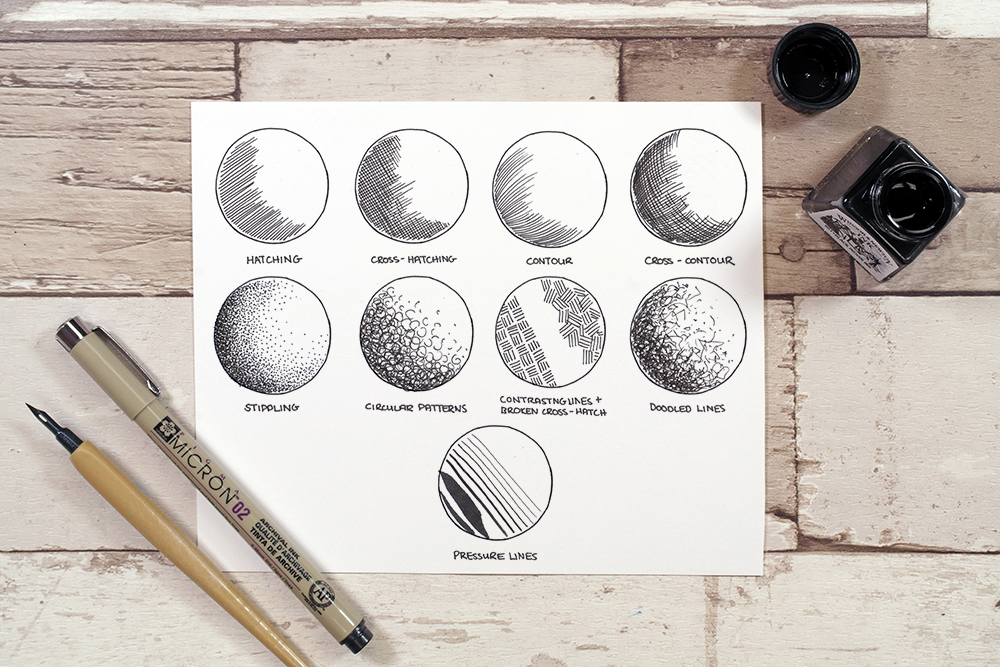
Pen and Ink are the perfect partners for quick and easy mark making – particularly as they are affordable and easy to transport. But working in a permanent medium can be daunting for beginners. Discover our meridian 9 easy pen and ink cartoon techniques to get you started!
Pen and ink is an aboriginal drawing medium that has been popular with artists for centuries. Nowadays, nosotros accept access to all kinds of wonderful pens that artists of days gone by could simply dream of! From fineliners and dip pens, to markers and brush pens – there are so many of these drawing tools to cull from. Each offer their own unique properties for pen and ink drawing.
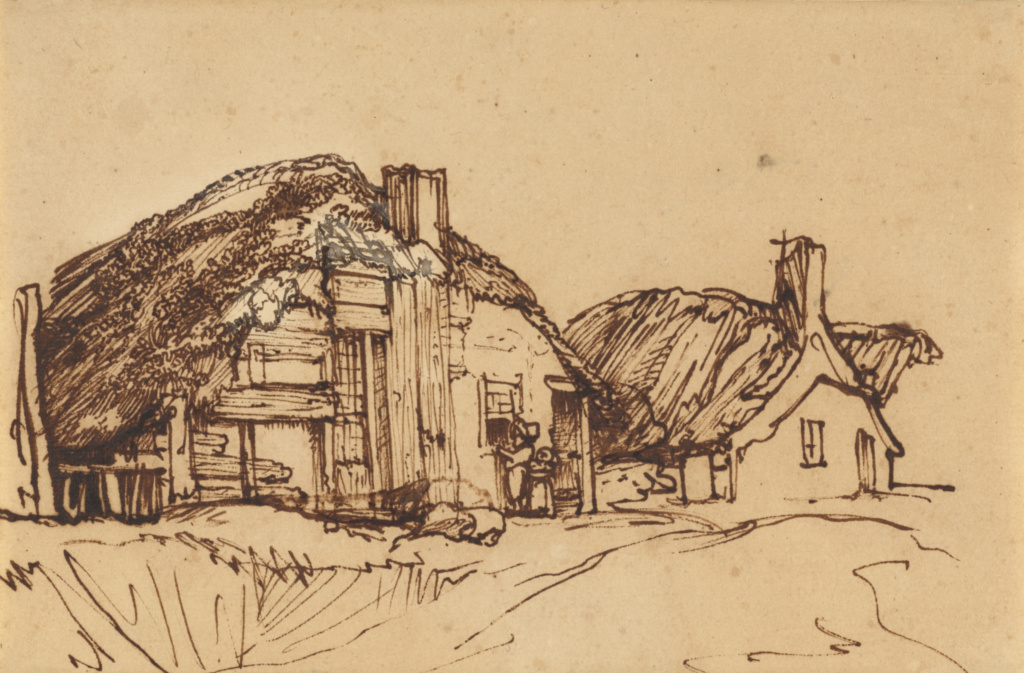
Pen and ink can seem similar a big step from pencil cartoon – especially for beginners! You lot tin't erase pen, dissimilar pencil, so your marker making must be advisedly calculated. At that place's nix worse than creating the perfect cartoon just for information technology to be ruined by one misplaced line! With pencil you lot are able to adjust your shading by varying the amount of force per unit area while drawing. This isn't the case with pens! You'll need to rely on carefully placed lines and marks to give the impression of shading. Tightly compacted linework volition requite the impression of deep shadows, while spaced out linework volition create an surface area filled with lite. Juxtaposing both these tight and loose marks will create a cartoon with slap-up contrast and texture.
The 9 like shooting fish in a barrel pen and ink techniques for beginners below offer a great starting signal, if you are looking to abound in confidence with your pen and ink technique.
What You'll Need to Become Started
If you're just starting out with ink drawing there are only a few bits of equipment you will need. Compared to painting, this subject field has a fairly low cost entry level, so is cracking for artists who are merely beginning their creative journey or who are looking to level up their drawing skills. To begin you lot will demand the following:
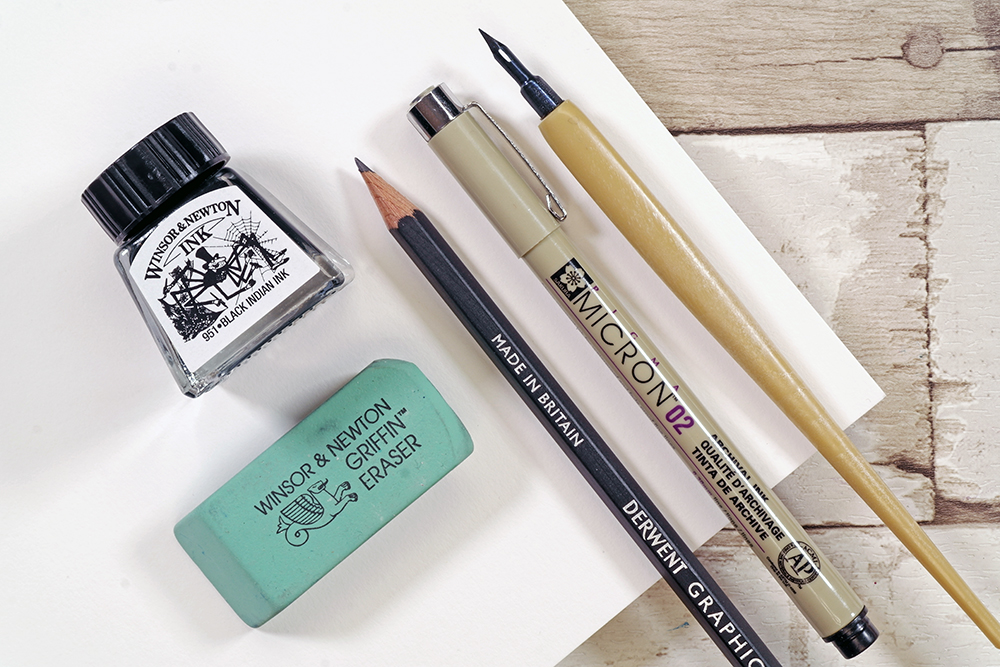
- A selection of cartoon pens.
- A dip pen, nibs and appropriate ink if you prefer working with a dip pen.
- Some Cartridge paper.
- Graphite Pencil & eraser if you would prefer to sketch before y'all ink.
One time you lot have these materials y'all will exist set up to go! Typically the materials you will need for pen and ink are easily transportable, and so if you're taking classes or working on the get creating fine art couldn't be easier!
What are the Differences Between the Types of Pen Bachelor?
At that place are and so many different types of artists' pens bachelor, it can be difficult to settle on the correct 1 for you lot. Particularly if you lot're a beginner! We'll take a await at a few of the variations of pens nosotros stock and explain the varying qualities they bring to pen and ink cartoon.
Fineliners & Technical Pens

Fineliner pens have a plastic or fibre based nib held in a metal casing. They accept very fine nibs, typically ranging from the smallest 0.03mm size upwards to 0.8mm, depending on the brand. The nibs all take a fixed width, so the line yous become volition be very uniform, consequent and skip-free. Most of our pens are pigment based and waterproof – so your drawings will be lightfast and can exist worked over with watercolour or ink later. All of our fineliners are bachelor in blackness, with select ranges available in other colours. Fineliners are the easiest pens to describe with if you're a beginner.
Discover more well-nigh our range of fineliners and technical pens in our web log mail service Become to know Artists Pens – Fineliners & Technical Pens.
Brush Pens
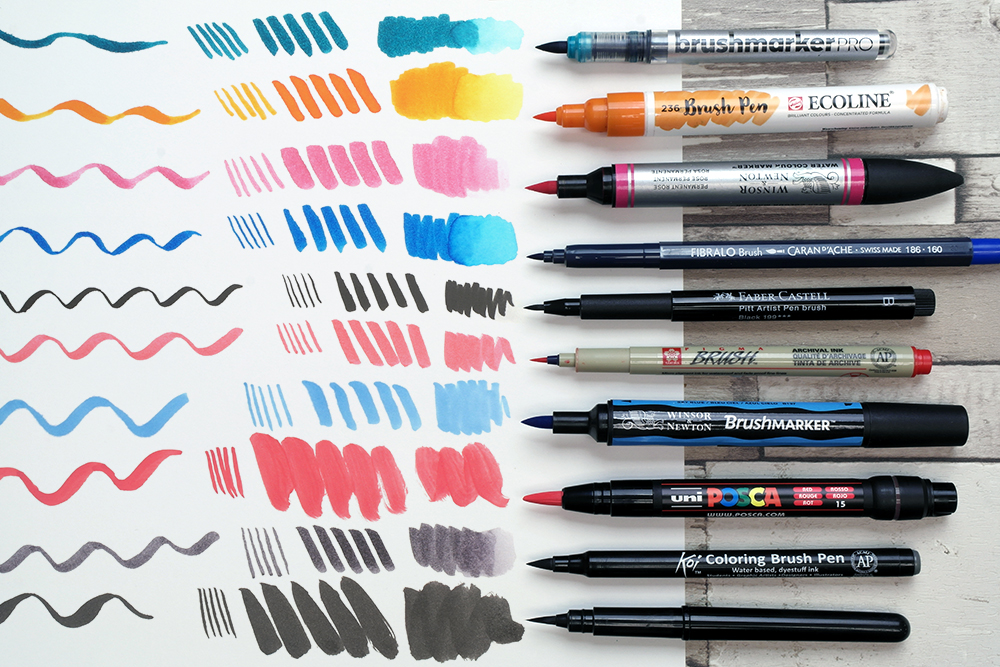
Castor pens offer more variation in line width than a fineliner pen. Their nibs have a broad base that then tapers to a fine betoken. Typically the pecker is fabricated of a conical slice of felt, but in that location are pens that have a true castor tip made of private fibres like a paint brush. You can vary the weight of your line by adjusting the amount of pressure y'all draw with. Light pressure will result in a fine line, whilst pressing downwards harder will create a thicker line. They are fantastic if yous want more diversity in line weight and style in your cartoon. Or are looking for a more versatile pen to experiment with. Some brush pens are water-soluble, so you'll need to double bank check this if you want ink that is permanent.
Discover more near our range of castor pens in our blog mail Get to know Artists Pens – Brush Pens.
Dip Pens
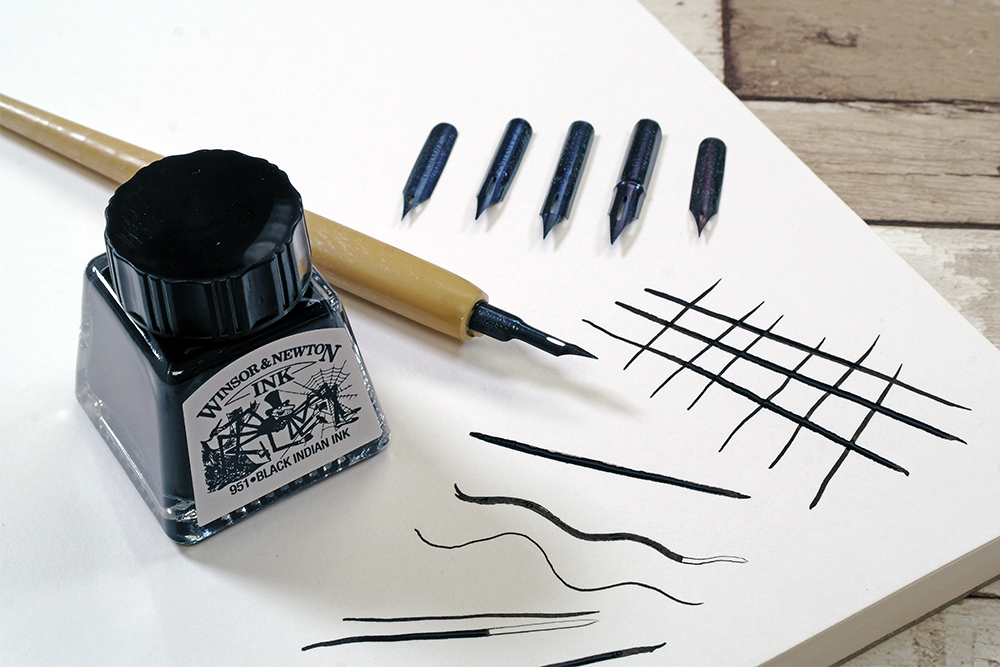
Dip Pens are not cartridge fed like fineliners and castor pens. Instead, you dip them into a bottle of ink and re-dip once the ink runs out. This technique is more than akin to the types of pen and ink drawing done by artists of the by. Ane benefit of dip pen drawing is that the colours available are most unlimited. Most bottled inks are suitable for use with a dip pen, so there will be plenty of colours to choose from! You too have the selection of working with either h2o-soluble or waterproof inks, depending on your preference.
Dip Pens don't give a uniform line. Every bit you utilise pressure the flexible tip of the nib will move, allowing more than ink to flow from the tip. They also have a tendency to splatter ink if the nib catches on your newspaper. For some people this splattering tin be an annoyance, merely for many it is part of the amuse of drawing with a dip pen. Nibs for dip pens are also interchangeable, so you lot'll be able to swap them out if you fancy a change.
You can use other speciality pens, similar calligraphy pens, for line drawing. These types of pens take specially designed nibs usually used for mitt lettering techniques. Y'all can utilise them to achieve precise marks and textures for drawing. They do require a bit of experimentation before you lot become the hang of using them.
Become started with the nine inking techniques below and you should slowly and surely exist able to build up your ink cartoon skills!
Technique 1: Hatching
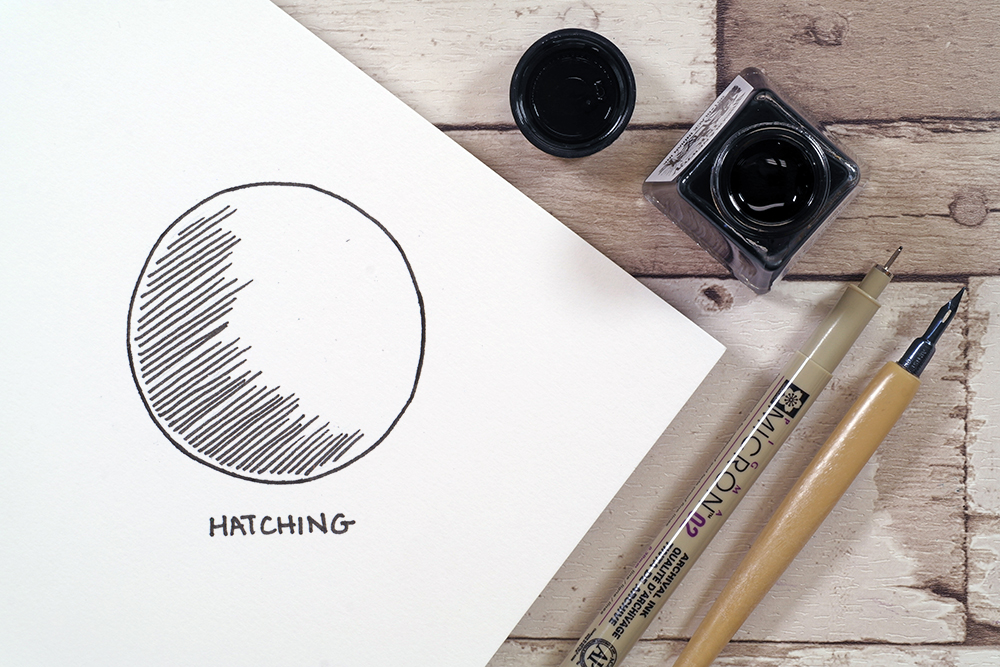
Hatching is the easiest and one of the well-nigh basic ink drawing techniques. To hatch you essentially create a series of horizontal parallel lines. Yous can apply a ruler to get sharp straight lines for an architectural look simply freehand lines will give your drawings more character. The closer together you draw your lines, the more dense the shading outcome they will create. The farther apart they are the lighter the shading will appear. This technique is best for shading areas with medium shadow.
Technique 2: Cantankerous-Hatching
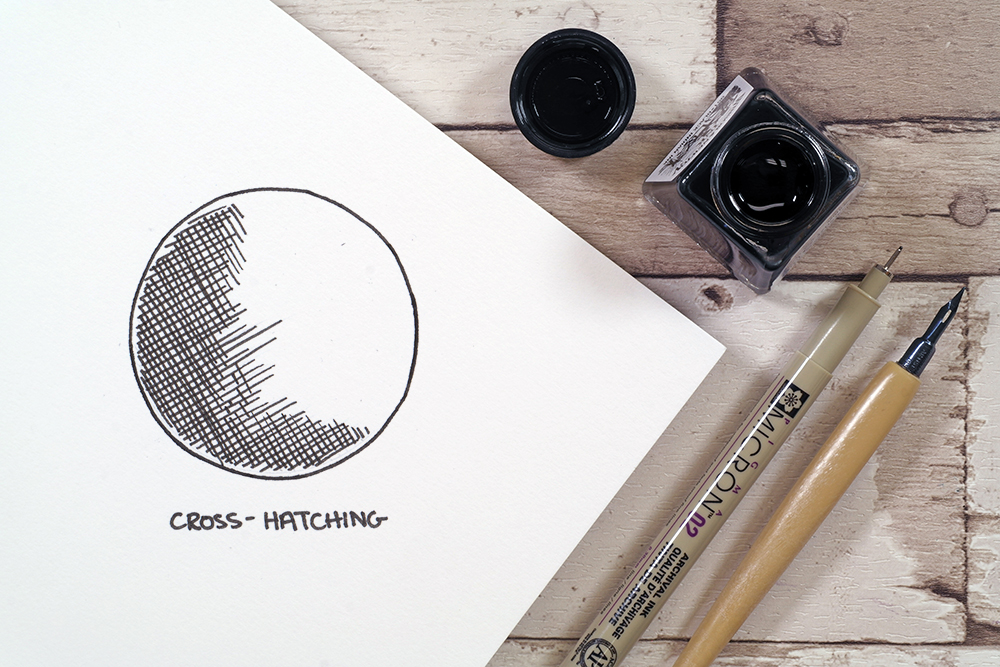
Cross-Hatching builds on the Hatching technique. Substantially you lot'll need to kickoff past creating the same hatched lines as earlier. Once you're done you'll create another layer of hatched lines that overlap your existing linework. This 2nd layer is commonly done at a 90 degree angle, simply y'all can add together them in as many layers and angles equally y'all choose. The more layers y'all add at different angles the more dense your shading will become. Use Cross-Hatching for creating areas of deep shadows while creating texture.
Technique iii: Profile
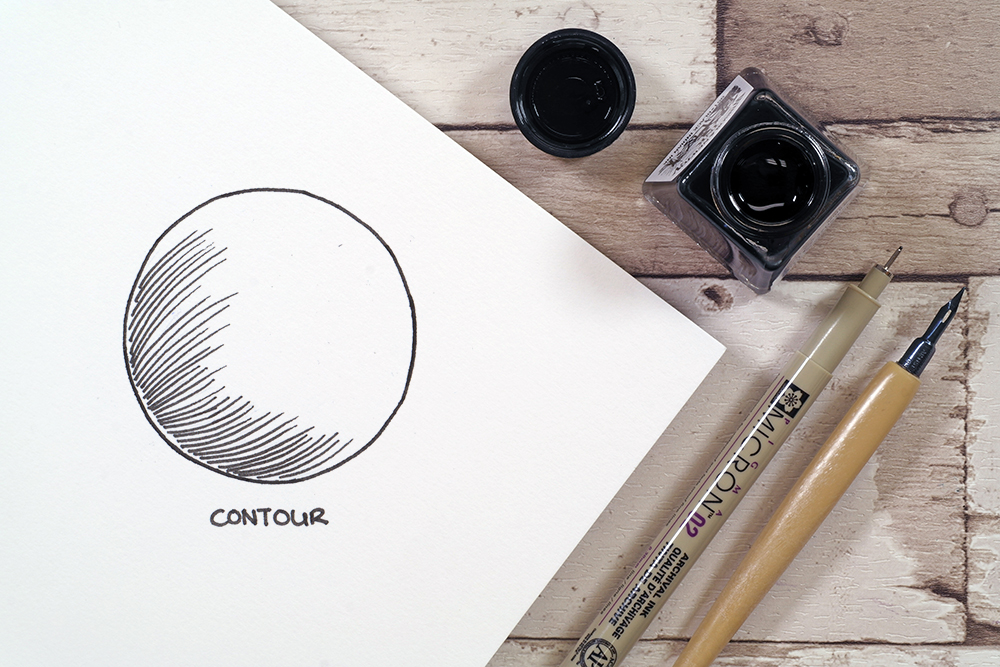
Contour shading works similarly to Hatching, but your lines will follow the curves of the object yous are drawing. If y'all are drawing a curved object and then using contoured lines over uncomplicated hatching will give more than illusion of shape. Hatching can leave your drawings looking a little flat. Every bit with hatching, the closer together the lines, the deeper the shadow consequence. Don't worry about your lines being perfect – lilliputian imperfections will give your cartoon character.
Technique four: Cross-Contour
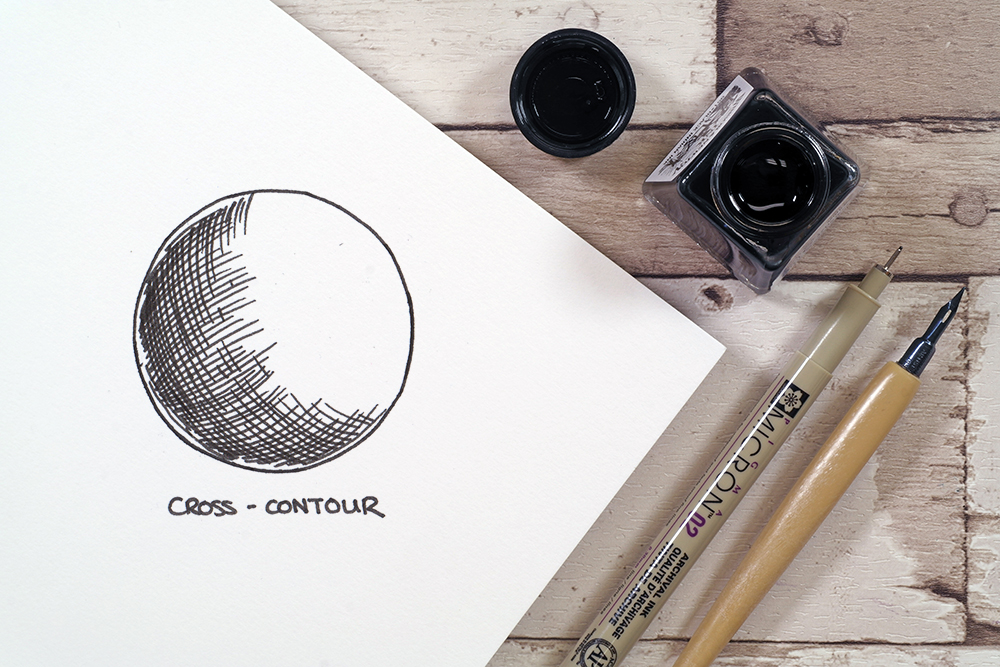
Cross-Contour works along the aforementioned principle as Cross-Hatching, just you lot will start with contoured lined rather than hatched lines. Again, you can add in equally many layers and directions as you desire to build upward the shadow density you need.
Technique 5: Stippling
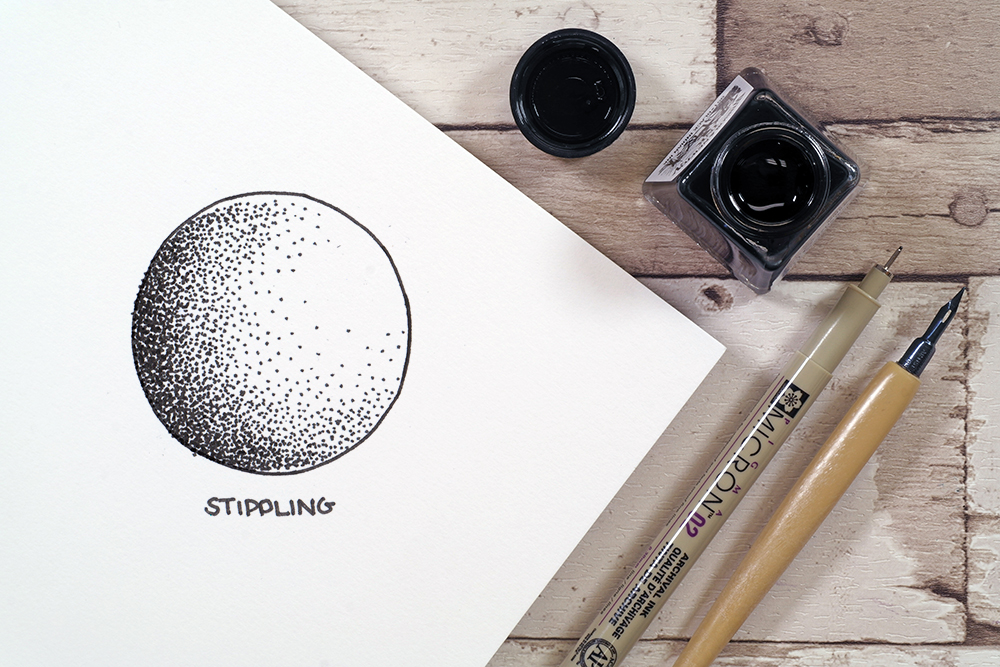
Stippling is one of the more fourth dimension consuming pen and ink techniques. It relies on carefully placed dots to requite the impression of shadow and depth. The more densely concentrated your dots, the deeper the shadow will be. Create each dot past pressing the nib of your pen against the paper – you aren't really 'drawing' and filling each private circle. The smaller the nib size of your pen, the smaller your stippled dots will be. In areas that have very piffling shading yous will just need to identify a few strategic dots hither and in that location. It tin have a long time to build upwardly your shading, especially if you re working on a large piece. Consider the size of the beak y'all use and don't lose your cool! This technique gives ultimate command over the contrast between light and dark in your work.
Technique 6: Round Patterns
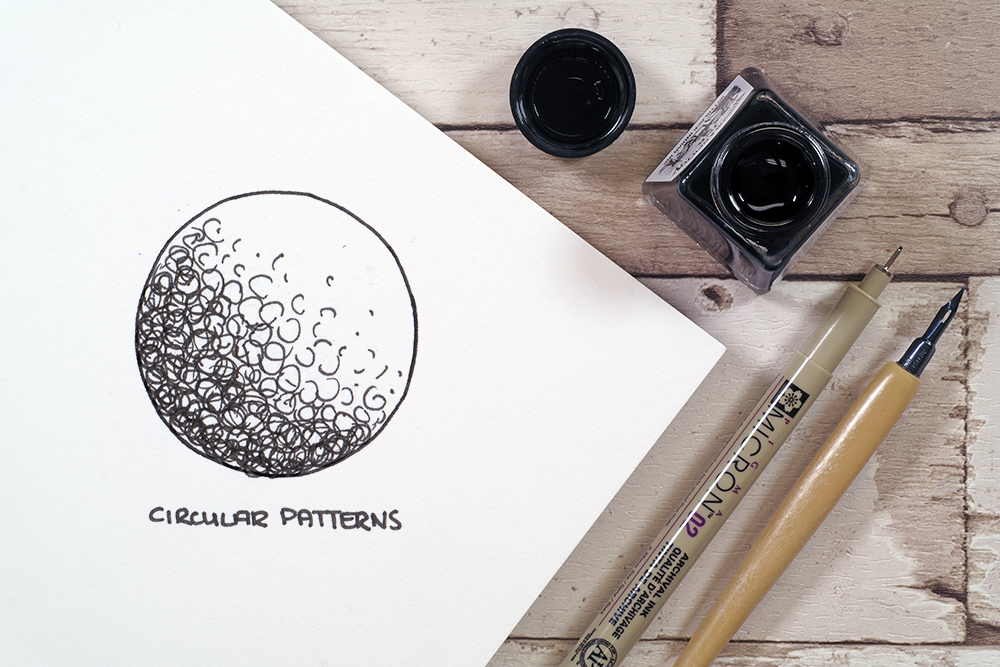
Use Circular Patterns to create areas of both light and night shadow. The larger, looser and less tightly packed your circles the lighter your shading will be. As your circles get smaller and more dense your shading volition appear much darker. This technique is great for quickly capturing natural textures in a uniform way – attempt using information technology to give the impression of foliage or scales.
Technique 7: Contrasting Lines & Broken Cross-Hatch
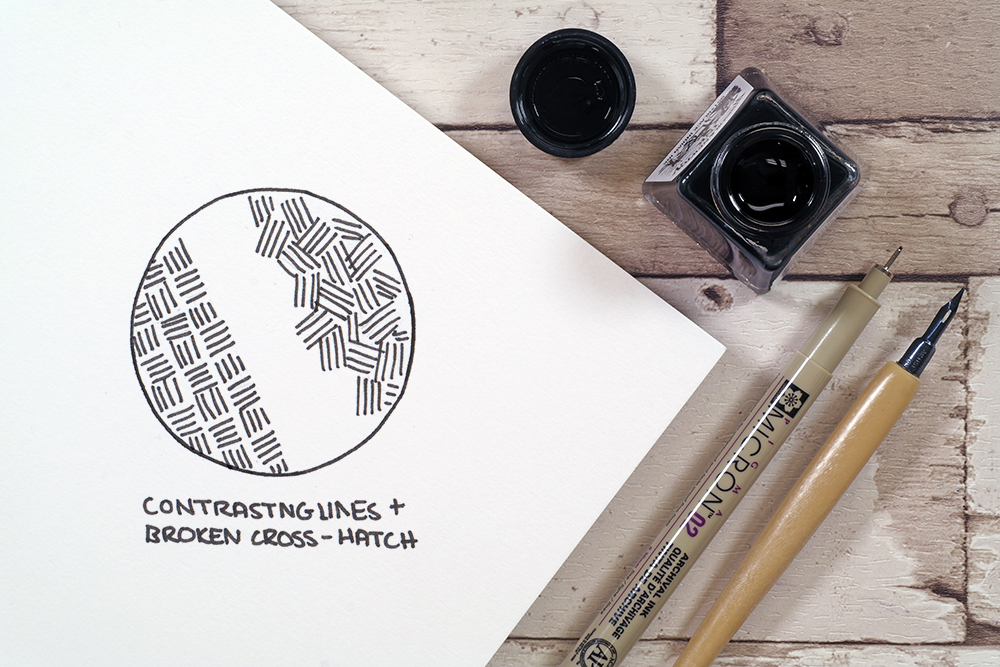
Contrasting lines and Broken Cantankerous Hatch are 2 similar techniques that piece of work the same mode every bit a regular cross hatch. Contrasting lines (sometimes called 'weaving') is used to create a pattern where pocket-sized groups of hatched lines are drawn at angles to each other. These lines can be fabricated in a uniform arrangement, or placed in a more random way depending on the texture you want to create. You can overlap these lines to create an unbroken pattern.
Broken Cross-Hatch is like but works with groups of intersecting cross-hatched lines. The more your lines intersect the darker the shading volition be. Both these techniques generate an aesthetically pleasing texture.
Technique 8: Continuous & Random Doodled Lines
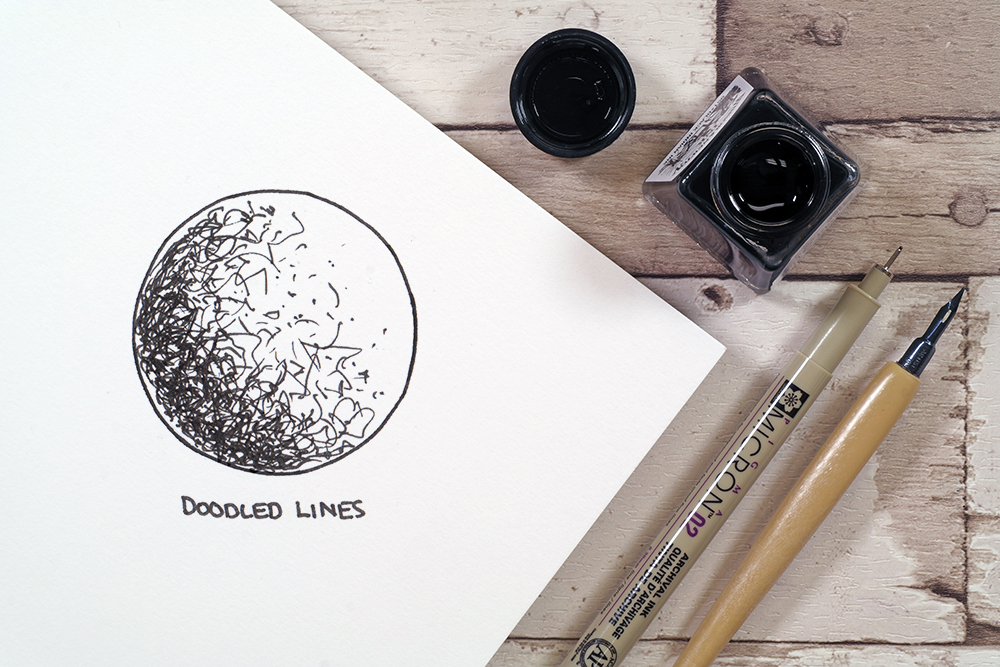
Continuous and doodled lines are commonly fabricated upwardly of one unbroken or a few very long weaving and overlapping lines. These lines shouldn't be made in any sort of anticipated design. Rather, yous should relax your hand and merely begin to create instinctive marks. It can take a picayune fleck of practise to permit go and relax, while also bearing in mind not to go overboard. Once y'all've practiced a little you'll shortly be able to create shading that's perfect for giving the impression of textures similar leaves, bark and more!
Technique 9: Pressure Lines & Thickness
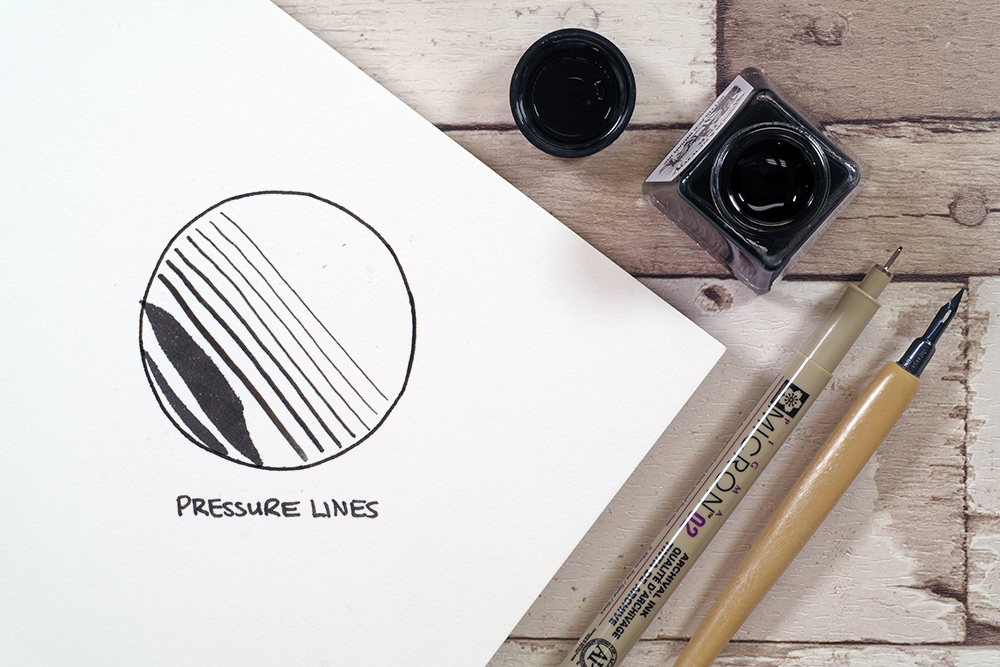
This technique makes employ of the different sizes and styles of nibs bachelor. If you lot are working with fine liner pens there volition be lots of unlike nib thicknesses available to you. Using a combination of these thicknesses in your drawings will make it easier to create varying degrees of shading. Attempt mixing upward the sizes of pens yous use to see how different sizes affect the types of linework you lot tin create.
With Castor pens you'll find that the more than force per unit area yous put on the pen, the thicker your linework volition exist. This allows you to create a unmarried line with a varying line weight – something that y'all can apply to your advantage in your drawings. The thickest lines can exist used to create dramatic shadows, while the variation in line weight will requite your drawing more character.
Other Hints & Tips
- If you're just starting out begin by practicing these techniques on simple geometric shapes. Starting time out with a cube and work out how low-cal and shadow will affect each of its faces. Try and translate this contrast in dark and light into a drawing using the techniques higher up.
- Equally you lot grow in conviction get-go trying to render more complex objects. Information technology can exist useful to draw these objects from life to run across how lite and shadow appear in a real life setting. Attempt capturing mugs, glasses and other household items.
- If you're nervous near putting pen to newspaper try planning your cartoon with pencil start. This planning will help you work out where your lines need to be placed, without worrying too much most making mistakes.
- Try pens with specialist nibs, like the Airplane pilot Parallel Pen for some interesting mark making techniques.
- Try mixing upwardly different techniques to help ascertain the form of the object you are sketching. Cross hatching and profile are commonly used together.
- Use a mixture of different pens in the same drawing.
- Change the manner you lot hold your pen. Holding your pen at the bottom volition allow for more free, expressive lines, whereas belongings it close to the bill volition let you to work in more than particular.
- Add water to h2o-soluble linework to add together character and interest to your drawing.
- Use dry pens for texture. Using a dry marking, felt tip or brush pen tin can add texture to your work as they create a broken stroke of ink.
- Use coloured pens to add a bit of vibrance to your drawings.
Source: https://www.artsupplies.co.uk/blog/9-easy-pen-and-ink-techniques-for-beginners/
Posted by: lesherporwhou.blogspot.com


0 Response to "How To Use A Dip Pen For Drawing"
Post a Comment